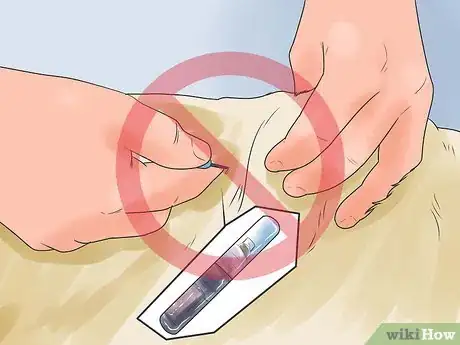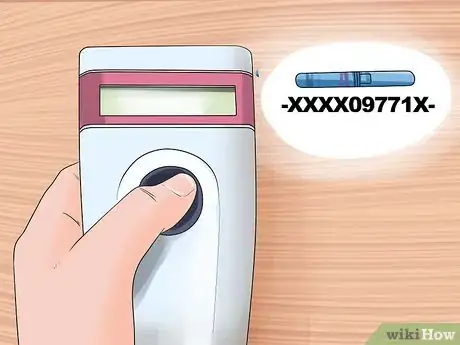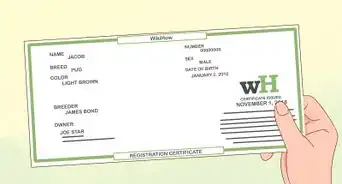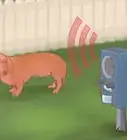This article was co-authored by Natalie Punt, DVM. Dr. Natalie Punt is a Veterinarian and the Founder and CEO of mPet- a smart phone app for pet owners to store, manage and transfer their pets medical records and health information. She specializes in small animal emergency and general medicine and veterinary practice economics. Dr. Punt holds a BS in Biochemistry and Molecular Biology from The University of California, Davis, an MS in Biochemistry from The University at Buffalo, and a DVM from Western University of Health Sciences.
There are 7 references cited in this article, which can be found at the bottom of the page.
This article has been viewed 50,273 times.
Microchipping is a technology used to locate your dog if she ever gets lost or is stolen. Collars and tags can be helpful when you need to find a missing dog, but there's always the chance that they could fall off. Microchips, on the other hand, are placed just under your dog's skin, so they're a more reliable and permanent form of ID. If your dog's collar comes off, a microchip is the perfect backup option, ensuring that you and your dog will be reunited much sooner.
Steps
Getting the Microchip
-
1Bathe your dog. Before you get your dog microchipped, she needs to be clean. This is so the injection site is nice and clean when the vet injects the microchip into your dog.
-
2Refrain from microchipping your dog yourself. You should not inject your dog with a microchip at home. It is illegal in many states to implant your dog yourself and you can have legal action brought against you. [1]
- Even if you are able to buy a microchip from a third part source, do not implant the chip yourself.
Advertisement -
3Take your dog to the vet. Microchips should always be injected by a qualified medical professional. It is much safer for your dog because your vet knows exactly where the microchip should be placed, how much pressure should be used, and what to look for in the rare chance there is any reaction to the microchip.
-
4Fill out the paperwork. When you are having your dog microchipped, you need to fill out the paperwork that comes with the microchip so the microchip is registered. The information that you list on these forms is how your dog will be returned to you if she is ever lost or recovered. Your vet will then send off the paperwork to the manufacturer's database for you.
- There is a fee to register the paperwork, which is often included in your vet bill.
- Make a copy of this paperwork if your vet doesn't offer you one. This will ensure that you have all the right information about your dog's microchip.[4]
-
5Check the microchip's ID number. Before your vet injects the microchip, she will place the microchip reader over the needle with the microchip in it to make sure it reads clearly and emits the right unique ID number.
- The number should match that on your paperwork.
- You should also keep this number for your records.[5]
-
6Have the nurse hold your dog still. Your vet can perform the microchip injection in the normal exam room. She will require the assistance of a nurse to help her with the injection. The nurse will gently hold your dog steady by placing one arm beneath your dog's body and gently place the crook of his arm under her neck.
- He will then hold the dog close to his body so she can't move.[6]
-
7Have the vet inject the microchip. Once the nurse has your dog secure, your vet can locate the place between your dog's shoulder blades where the chip will be implanted. You vet will gently pull up the skin in this area and she will implant the microchip, about the size of a grain of rice, directly under the skin with the applicator.[7]
- The skin doesn't need an alcohol swab or other preparation as long as your dog is clean.
-
8Recheck the microchip. Once the microchip is implanted in your dog, the vet will recheck the chip to make sure it is still transmitting now that it is in your dog's skin. Once the number reads the right unique ID, your dog is ready to go.
- Your vet will also routinely check the chip once a year to make sure it is functioning properly.[8]
-
9Keep your information up to date. If you move, change your phone number, or if any other contact information changes, make sure you tell your vet or contact the manufacturer's database about your change in information.
- They will update your information as soon as possible so your dog can be returned to the right place if she goes missing.[9]
Considering a Microchip
-
1
-
2Understand how a microchip works. A microchip is a device that emits radio waves at a certain frequency. There are typically three different frequencies that a chip may emit at, but there are universal readers that will read all three frequencies. When the frequency is read, the reader will display the unique ID number attached to your paperwork as well as the manufacturer of the chip. This will tell them which database to contact in order to find your information.
- The chip itself does not contain your contact information. It just has your unique ID, which is used to access your paperwork.[12]
-
3Know how long microchips last. Microchips do not run on power. They simply reflect a signal back to the scanner. Once your dog has been implanted with a microchip, it will last for her whole life.[13]
-
4Learn how much microchips cost. Most vets charge between $25 to $50 for the implantation of a microchip. This will vary depending on your vet.[14]
-
5Be aware that it doesn't affect your dog's health. Microchipping has a very minimal chance of any side effects. There is only a small pain felt when the microchip is injected, similar to that of any shot. Your dog may react to this a little bit, but it will only sting for a few moments.
- If your dog is smaller, there may be a little more pain at the moment of injection because she has less padding.
- No surgery or anesthesia is required to implant the microchip. However, many owners opt to have the microchip implanted at the same time she is spayed (or neutered if male) so she gets both procedures handled at one time.[15]
- There have been a few documented cases of extreme side effects, such as microchip migration that leads to abscesses or, in one case, death, but these are very rare.[16]
Expert Q&A
-
QuestionCan you track your dog with a microchip?
 Natalie Punt, DVMDr. Natalie Punt is a Veterinarian and the Founder and CEO of mPet- a smart phone app for pet owners to store, manage and transfer their pets medical records and health information. She specializes in small animal emergency and general medicine and veterinary practice economics. Dr. Punt holds a BS in Biochemistry and Molecular Biology from The University of California, Davis, an MS in Biochemistry from The University at Buffalo, and a DVM from Western University of Health Sciences.
Natalie Punt, DVMDr. Natalie Punt is a Veterinarian and the Founder and CEO of mPet- a smart phone app for pet owners to store, manage and transfer their pets medical records and health information. She specializes in small animal emergency and general medicine and veterinary practice economics. Dr. Punt holds a BS in Biochemistry and Molecular Biology from The University of California, Davis, an MS in Biochemistry from The University at Buffalo, and a DVM from Western University of Health Sciences.
Veterinarian Definitely! Veterinary hospitals (as well as rescue agencies, shelters, and pounds) have universal microchip scanners that can scan your dog's microchip and retrieve their information. Using this information, the owner can be contacted.
Definitely! Veterinary hospitals (as well as rescue agencies, shelters, and pounds) have universal microchip scanners that can scan your dog's microchip and retrieve their information. Using this information, the owner can be contacted.
References
- ↑ https://www.avma.org/Advocacy/StateAndLocal/Pages/scope-unauthorized-practice.aspx
- ↑ Shelter Medicine for Veterinarians and Staff. Editors Lila Miller, DVM and Stephen Zawistowski, PhD and CAAB. Blackwell Publishing. 2004
- ↑ https://www.avma.org/KB/Resources/FAQs/Pages/Microchipping-of-animals-FAQ.aspx
- ↑ https://www.avma.org/KB/Resources/FAQs/Pages/Microchipping-of-animals-FAQ.aspx
- ↑ https://www.avma.org/KB/Resources/FAQs/Pages/Microchipping-of-animals-FAQ.aspx
- ↑ https://www.avma.org/KB/Resources/FAQs/Pages/Microchipping-of-animals-FAQ.aspx
- ↑ https://www.cesarsway.com/cesar-millan/cesars-blog/should-you-microchip-your-dog
- ↑ https://www.avma.org/KB/Resources/FAQs/Pages/Microchipping-of-animals-FAQ.aspx
- ↑ https://www.avma.org/KB/Resources/FAQs/Pages/Microchipping-of-animals-FAQ.aspx
- ↑ https://www.aspca.org/animal-homelessness/shelter-intake-and-surrender/pet-statistics
- ↑ https://www.aspca.org/about-us/press-releases/how-many-pets-are-lost-how-many-find-their-way-home-aspca-survey-has-answers
- ↑ https://www.avma.org/KB/Resources/FAQs/Pages/Microchipping-of-animals-FAQ.aspx
- ↑ https://www.petfinder.com/dogs/lost-and-found-dogs/microchip-faqs/
- ↑ https://www.cesarsway.com/cesar-millan/cesars-blog/should-you-microchip-your-dog
- ↑ https://www.avma.org/KB/Resources/FAQs/Pages/Microchipping-of-animals-FAQ.aspx
- ↑ https://www.cesarsway.com/cesar-millan/cesars-blog/should-you-microchip-your-dog
About This Article
If you want to microchip your dog, start by giving your dog a bath to prepare the skin for the injection. Next, take your dog to the vet to get the microchip injected between your dog's shoulder blades. Then, fill out the paperwork required to register the ID number on the microchip. Before submitting the paperwork, make sure all of the information is correct and up-to-date, especially your contact information. If you move or change your phone number, don't forget to notify your vet or the microchip manufacturer so they can update it in their database. To learn more about how microchips work, read on!








































































